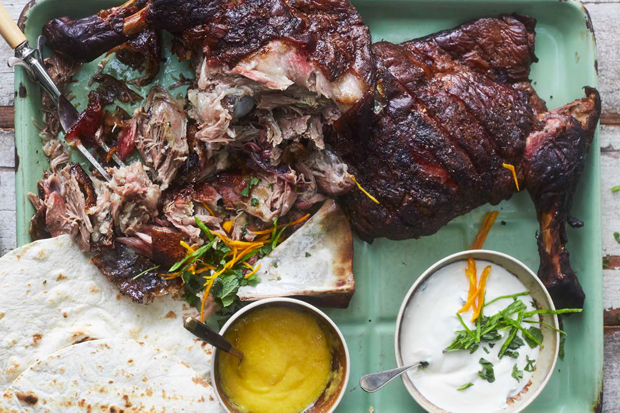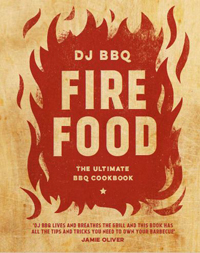Recipe
June 22, 2018
DJ BBQ’s Next-Level Lamb Wrap

Try this Next-Level Lamb Wrap recipe from the cookbook Fire Food.
 Lamb is easily one of my favorite meats to cook and lamb fat is the best. There is no better flavor in my opinion. It’s quite common to cook a leg of lamb or shoulder in the oven. But how about smoking one of these working muscles? The shoulder has loads of fat and connective tissue, so it really works well with a slow and low cook. A good-sized lamb shoulder can take anywhere from 3½ to 6 hours depending on the size, how the animal was raised, the fat content, and other factors. It loves a good basting: this helps keep the joint nice and moist and adds layers of flavor. Let’s get to it.
Lamb is easily one of my favorite meats to cook and lamb fat is the best. There is no better flavor in my opinion. It’s quite common to cook a leg of lamb or shoulder in the oven. But how about smoking one of these working muscles? The shoulder has loads of fat and connective tissue, so it really works well with a slow and low cook. A good-sized lamb shoulder can take anywhere from 3½ to 6 hours depending on the size, how the animal was raised, the fat content, and other factors. It loves a good basting: this helps keep the joint nice and moist and adds layers of flavor. Let’s get to it.
Directions
Yield: Serves 8 to 12
- You need to get your cooker to 120–130°C (250–265°F).
- Take the lamb shoulder out of the fridge at least an hour before the cook — it’s got to be at room temperature when you put it on the grill. Take a sharp knife and lightly score the fat. You are creating more surface area for the rub and basting sauce. Plus, you are giving the fat a bit of a head-start as it slow-cooks and renders down, flavoring the meat.
- Put all the rub ingredients into a bowl and mix well. Massage the olive oil all over the scored lamb shoulder, then rub your meat liberally with the seasonings.
- Place the joint into the cooker/firebox, or as far away from the heat source as possible if you are using the lonely island technique. Add seasoned wood chunks to your fuel, put the lid on, and slow-cook that baby!
- Make the baste by combining the water, vinegar and apple juice. Do not touch the lamb for the first hour; this will help create a tangy crust and keep the moisture in. After the first hour, baste the lamb, then baste again every 45 minutes or so. Cook your dirty onions (see below) while the lamb is doing its thang. Don’t forget to keep your fuel topped up.
- The lamb is done when it’s done. There is no exact timing. You’ll need to keep an eye on the joint and do some prodding.
- There should be a bit of give when you touch the meat and you want to see the meat pulling away from the bone. When the meat starts to fall off the bone, then you have a major success story.
- Rest the lamb under loose foil for 30 minutes. While the lamb is resting, make your wrap sauce. Dirty-cook the chillies by placing them on the used coals. Keep turning until charred. Remove and let them cool.
- Chop two of the chillies for the sauce and save two for serving. Add the chopped chillies to the yogurt, along with the honey, lemon juice, tahini and mint leaves.
- Peel the cooled dirty onions and roughly chop. Add them to the wrap sauce. Have a taste. Pretty ding dong dang tasty, right?
- Pull your meat! Tongs and a fork work well here. You’re looking for nice chunks of tender meat with a crispy smoky outside crust.
- Quickly toast the tortilla wraps. Layer the meat inside, spoon on the wrap sauce and garnish with a few mint leaves. Add the remaining chillies for extra heat. And get some aioli on there too, if you like. Enjoy!
Dirty Onions
- Make sure your coals have properly cooked down and are not too fierce. The coal bed should be evenly laid out.
- Whatever you do, do not peel the onions. You need the outer casing to protect the sweet tangy flesh within. Once the coals are good to go, take a pair of tongs and carefully place the onions straight into the coals. Push the coals around the onions so that they get hit from all sides. You don’t need to cover the onions as you’ll turn them a couple of times during the cook.
- The big ones should take anywhere from 1½ hours to 2 hours. The perfect dirty onion will ‘pop’ from the top. This is when the center gets hotter than the sun and erupts like a volcano. Be careful of the lava. Not every onion will pop but the majority do. To make sure the onions are done, give them a squeeze with the tongs. They should be really quite soft. Be careful not to overcook them, as once the moisture has been cooked out, they will go hard as a rock, especially if they are small ones.
- Carefully take the onions out of the coals and rest them on a baking tray (sheet) covered with foil. This helps the onions rehydrate. Be careful in case there are any coals, which can sometimes stick to the onions. You can use them right away but they are pretty hot. We normally cook onions in the morning and let them cool down for a couple of hours before handling.
- The best technique for getting into the goodness is to squeeze the skin and pop the onion out. Remove the ash and dried skin but don’t worry if little bits of charred skin remain – they only add flavor and texture. These can now be chopped and used in a variety of recipes or as a condiment. Soak them in a little bit of cider vinegar and a pinch of salt for next-level flavor.

